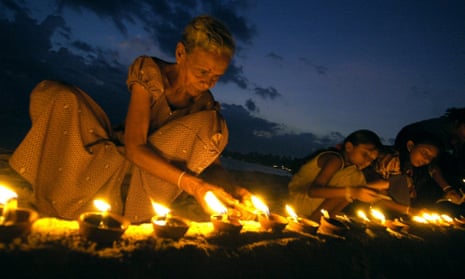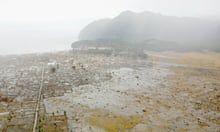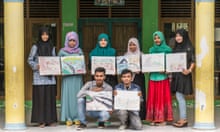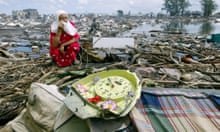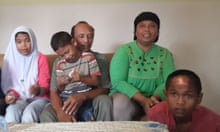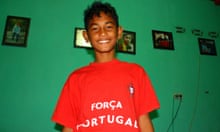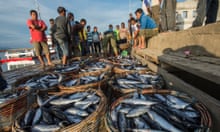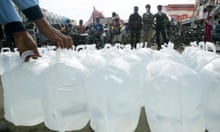The tsunami that followed the Indian Ocean earthquake on 26 December 2004 was one of the worst natural disasters on record, killing almost 250,000 people across 14 countries. Indonesia was the hardest hit, followed by Sri Lanka, India and Thailand. We’ve asked readers who were affected by the tsunami to share their memories. For most their experiences of that day had life changing consequences.
Jaime Aldridge: “I was 13 years old when I witnessed the tsunami ... mostly I felt guilty that I could get on a plane and escape the suffering”
Jaime wrote about her experiences on the plane on the way home: “Me and my family were staying at a beach hut in Unawatuna, Sri Lanka for Christmas. On Boxing Day at 9:00am we planned to go on a snorkelling trip out at sea. We woke up at 8 and got on the boat at 9:10 which was incredibly lucky due to the experience ahead of us ... So we sailed out to sea in a fishing boat. We kept circling the island while the fisherman explained that the sea was too rough snorkel and was very dangerous. At this time we were getting a bit aggravated that we wouldn’t be able to snorkel! At the bottom of the fishing boat was a small square of glass down into the sea. We kept looking in it, and every time it looked dark and sandy so we couldn’t see through it.
“My aunt Becky was very sea sick at this time and wanted to get off the boat. The fishermen went to take us back to shore and the sea had become so rough it was swirling around like mini tornados. So the fishermen sailed us around the corner to another city called Galle, when we got closer, three fishing boats shot out of the mist shouting “GO GO OUT TO SEA NOW, WAVE 100FT WAVE! GO!” we hadn’t a clue what was happening, but we took their advice anyway. We sat in a boat out at sea, with my aunt being sick, my mom worried, my dad laughing about the whole affair and my grandma was reassuring my aunt. We waited two hours for what we thought was just a rough sea. We glanced at our hut and the hotels on the beach and realized that it was all destroyed. Still at this point we did not realize the extent of the damage. We sailed towards the beach where TV’s, tables and domestics (equipment) were in the sea. I caught a glimpse of something floating in the sea, and when we got closer we apprehended that it was a floating corpse of a baby and next to it an old man.

“I was the first off the boat and I ran to where the men were pointing for us to go. A man pulled me up onto a ledge and then we ran though a broken down restaurant to a plot of land where all the waiters were. We got to know the waiters very well during our stay, so they were concerned about us and were all glad to see us alive, as they had all suffered dramatic experiences on land. My family ran over to me, and we were all told to run up the street. I had no shoes because I left them in the room, so I was running bare foot until a kind middle-aged man, looked at my feet and gave me his own shoes. My mom and dad began to run and so did I. we still didn’t know what had happened. We ran up the street where some locals stopped us and took us inside to eat and drink.
“We were sitting down in their yard, when tourists and locals began to run in horror. Another wave was coming. The people that were looking after us took us along an alley; to some trees with ropes which led up into a mountain; which we remained until the streets were safe. In the mountain were a few families and we were lucky to be up there ... we were told by passing tourists to go to the temple to get food ... after three hours of watching homeless, upset, missing, children and adults walk past, my dad and uncle went to find a safe hotel to stop the night in ... after that we went to visit our broken down Beach hut to try to find our things. I found some clothes of mine in the wreckage. My mom found her favourite picture and some of her clothes. Most things were destroyed, missing or 300 yards up the road. Everything was now getting a bit emotional and my mom began to cry as she looked at the damage that nature can do to our civilisation ...
“We were reported as missing on BBC. BBC said that a British teacher and his family were on a boat when went missing. This was us. My uncle is a British Council Teacher, so we had people looking for us ... We are extremely lucky to get away from the disaster than has killed thousands.”
Andy Chaggar: “I lost the woman I loved ... as a result I’ve spent virtually every day since trying to make the most out of life and do what I can to make a difference”
“In December of 2004 I travelled to the town of Khao Lak, in Thailand, with my partner Nova Mills. Nova and I had been together for almost six years and were about seven weeks into a planned one-year trip around the world. We’d had a great time on our trip so far, having travelled through China, Vietnam and Cambodia, but we were really excited to meet up with three friends from home whom we met in Bangkok. We had a great few days catching up and then Christmas itself couldn’t have been more perfect. We spent a lot of the day just relaxing on Khao Lak’s Nang Thong beach talking, laughing a lot and keeping ourselves cool by taking regular dips in the ocean.
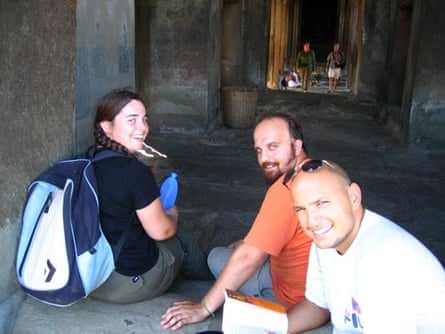
Once the sun set we all took showers and then met in the restaurant of the guesthouse four of us were staying at. This was a very small family run place no more than 30 metres back from the beach and sadly I’ve never been able to remember the name. We returned to the beach where we sat laughing and raising glasses until the very early hours. I think we finally made it to bed around 4am.
“Because of our late finish the night before we were still in bed the next morning when the tsunami reached Khao Lak. I remember waking up in our bungalow and Nova had just risen on the other side of the bed. The room was shaking and this became more violent as I tried to work out what was going on. Our bungalows were close to the beach but were perpendicular to the shore so we couldn’t see the wave approaching. There was a noise however that I’ve only ever been able to describe like a jet engine building up, and between that and the shaking we knew something was wrong. I made it to my feet and remember Nova on the other side of the bed looking scared. That was the last time I ever saw the woman I loved as the first wave then slammed into our bungalows.
“When I came to again I was in the water. This may sound strange but at this point I didn’t remember being in the bungalow moments before. The impact must have been so powerful that I was knocked unconscious and totally stunned. All I knew at this point was that I was in serious trouble. I was being swept along by the most powerful current I’ve ever felt. The water was also full of debris. Wood, metal, glass, bricks and everything else you can think had turned the wave into a thick soup. Swimming was futile, it was like being in a giant washing machine full of nails on a spin cycle.
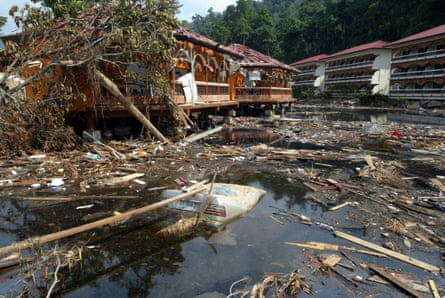
“Somehow, luckily, I was washed through a building site, I think perhaps of a new resort being built. The structure had columns and floors but no walls as yet. As I was swept through my left leg became trapped against one of the columns and I was then pinned there by debris. I immediately felt excruciating pain and I lost a lot of tissue and muscle on my calf. But I think this saved my life as it stopped me being swept out to sea where I would likely have been killed. I was then trapped on this building site for around four hours. I was too injured to stand, let alone walk, and even sitting up was hard at times.
“As well as my left leg I’d broken my right collarbone and had been pretty badly battered all over. At that point I had no idea what a tsunami was, let alone how big the larger event was, so I couldn’t understand why official help wasn’t coming. Various other survivors wandered into view at times but seemed too shocked to help. A group of locals arrived at one point and tried to help, but a second wave approached and they were forced to flee. Luckily I was trapped on a higher floor and the second wave passed underneath me.
“Eventually a small group of other westerners found me and helped me to the main road in Khao Lak. I was immediately put into a pick-up truck however so didn’t get a chance to get their names or details. Over the next 10 days I was moved through various hospitals, some in the immediate area, but later onto Bangkok. I had three surgical operations in Thailand to debride the infected tissue on my leg and there was a lot of concerns about my injuries. However, after my immediate rescue my biggest pain was always in relation to Nova. The scene in the bungalow had come back to me by now, and after also seeing so many bodies in Khao Lak I was virtually certain she hadn’t made it.
“After being flown home to the UK, I spent seven weeks in hospital and then seven months doing physiotherapy. All I could think about through this time was where we were supposed to be on our trip and what we were supposed to be doing together. I knew I needed to find an outlet for my grief, and I’d also been incredibly moved by seeing the devastation first hand in Thailand. So, when I felt able, I returned to Khao Lak in August 2005 and joined an organisation called the Tsunami Volunteer Centre (TVC). I almost immediately became project manager for the construction of 67 homes in the village of Tap Tawan, north of Khao Lak. I spent the next year as a volunteer and the process was incredibly important to my own recovery. Seeing how local people, who had often lost so much more than me - I still had a house, family, money, etc - were able to cope and begin to smile again helped to put my own situation in perspective. I was also massively inspired by the steady stream of international volunteers who came to help and who worked so hard day after day to help affected communities.
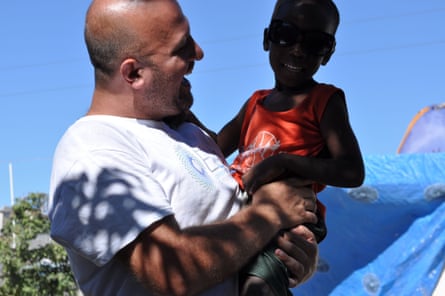
“As time progressed my personal interest in aid work became a professional one. So, I returned to the UK and obtained my masters in degree in International Development, with a focus on disaster recovery. I wrote my dissertation on community based disaster recovery in Thailand and was awarded the Andrew Lochhead Prize for International Development. After this I travelled to Peru after an earthquake where I again volunteered as a construction manager, although this time for sanitation projects. While in Peru I began speaking to some other long-term volunteers, many of whom who had also been in Thailand as well, about starting a charity ourselves. So, in late 2008 we co-founded International Disaster Volunteers (IDV).
“It was incredibly tough founding a charity at the start of the financial crisis. None of us had savings or wealthy contacts and it took us almost a year to raise the £5,000 needed to register as a charity. However, by the end of 2009 we had charitable status and were ready to start overseas operations as the 2010 earthquake struck Haiti ... As the ten year anniversary of the tsunami approaches I’m reflecting on my journey since and trying to raise awareness of IDV’s work. Since IDV started we’ve raised over £500,000 and supported the recovery of over 12,000 disaster survivors. It’s been quite a journey, with some massive ups and downs. Ultimately though, it all comes down to that day in Khao Lak 10 years ago and my own personal experiences of disaster. I lost the woman I loved and was lucky to survive myself. As a result I’ve spent virtually every day since trying to make the most out of life and do what I can to make a difference. After all, I know more than most that anything could happen tomorrow.”
UbudHighDotcom: “There was so much devastation that single images just didn’t capture the enormous scale of the tragedy”
“I was in Karnataka in West India when the tsunami hit, and went over to the southeast to see what had happened. I spent a week walking the beaches around Nagappatinam, which was very hard-hit.

“This is what was left of a fishermen’s village a couple of kilometres from Nagappatinam. I shot on 35mm film, and then stitched the panoramas up in Photoshop. There was so much devastation that single images just didn’t capture the enormous scale of the tragedy. It was very hard to photograph - there was absolutely nothing aesthetic about any of it. A very ugly scene. I didn’t go into the sea for two years after this - I kept thinking about all of the dead bodies washing around in it.”
Ian Woolverton: “I remember feeling sick and utterly useless as I listened to his story then muttered a few words of condolence via a Red Cross translator”
“I’d done other humanitarian assignments for Red Cross but this was of a scale no-one had experienced. I’m not embarrassed to say I was afraid and apprehensive that I would freeze and be unable to do my job of getting the message out about our response. Within days I was on a chopper from Medan on Sumatra, Indonesia to Banda Ache where I was met by an ICRC colleague. Our makeshift office was a car showroom. I was not there that often since I spent many weeks travelling all over Ache to places like Teunom and Meulaboh on the West coast, places that at the time had not been accessed by aid. I was amazed at the speed with which Red Cross established field hospitals in places that were incredibly difficult to access by road, a chopper was often the only way in. And of course I will always remember the terrible death and destruction. I remember telling Andrew North from the BBC that it was like an atom bomb had exploded, everything flat, featureless, pancaked. I remember sleeping on the cold hard concrete floor of a hospital in Meulaboh with a medical team from Japanese Red Cross, the BBC in tow.
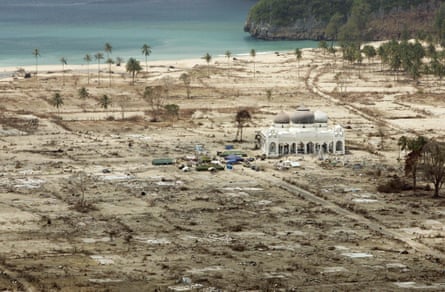
“But what I remember most of all is meeting survivor after survivor who told me awful heart wrenching stories of loss and anguish, like Yassir, a bi-cycle salesman whose hand had slipped from his wife’s as they were carried away by the waves. His wife was expecting their first child. Eventually he found his wife’s body in a bus stop. Eyes glazed, he carried a haunted expression that I will never forget. I remember feeling sick and utterly useless as I listened to his story then muttered a few words of condolence via a Red Cross translator. Over the course of a month in Ache I heard stories like this over and over again. But I also got to see the work of Red Cross volunteers from all over Indonesia who came to help the people of Ache. I was in awe of these young volunteers who toiled long days in the fetid heat and humidity to retrieve bloated bodies from among the never-ending debris. I was privileged to witness the work of the Red Cross doctors and nurses who worked tirelessly night and day to help the tsunami survivors. My time in Ache changed me forever. I am so grateful to have witnessed the humanity in this terrible disaster and to have been among people whom sacrificed so much to help other people. It was a deeply humbling experience, one I will carry with me always.”
Ian Woolverton was the International Federation of Red Cross and Red Crescent Societies Media Manager in Ache from December 2004 to Feb 2005. He is now Head of Media for Save the Children Australia
Josie Breen: “When the first reports came through nobody could get in touch but it was thought the networks were down”
“A few of my family spent Christmas night at my Aunt’s in Edinburgh. Her son Dominic had called earlier from his holiday on Ko Phi Phi (Thailand) with girlfriend Eileen to wish a happy Christmas, saying it was paradise there. When the first reports came through nobody could get in touch but it was thought the networks were down. There has since been footage of the terrible speed and size of the event, but at first it looked like something a strong, young couple would overcome and survive. They hadn’t. The whole family misses him and will be remembering him, Eileen, and thinking of the thousands of others on the 10-year anniversary.”
Alinah Azadeh: “I could not square the fact that I had finally given birth to her long awaited grandchild, and she had promptly disappeared”
“My daughter Delia, my first born, was three weeks old when we woke up on Boxing Day 2004. My mother, Parvin Rieu, who had been with me prior and through the birth - cooking delicious Iranian food and praying quietly in the corner - had managed with her partner, Reg, to get a last minute booking to Phuket for a recovery holiday over Christmas. We had spoken the day before and she had described the ‘paradise’ they were staying in.
“The first I knew something was up, was a call from my brother to say not to panic if I saw the news about a tidal wave in Asia, he had called her hotel, which was on a hill, and everyone was accounted for. A few hours later, he called again to say that, the hotel had informed him that there were in fact, a few people missing, - those who had been up early after the previous nights celebrations for a beach walk- and my mother and Reg were among them. As the hours dragged on, I sat there, breastfeeding Delia, and a feeling of dread and disbelief grew as we realized the extent of the disaster and the utter chaos that was unfolding in the wake of the Tsunami. We heard a few days later that Reg had been rescued and was later flown home. When he told me on the phone that there was no way my mother could have survived I simply did not believe him.

“Even when my brother flew out there to look over thousands of bodies in the temples that were temporary morgues and sent me an email saying there was no hope, I still held out for her turning up on some remote island, having nursed others back to life as I knew would be in her nature to do so. I could not square the fact that I had finally given birth to her long awaited grandchild , and she had promptly disappeared. We had talked so much about the role she would play in Delia’s life and the miracle that having a new child in the family was to her. As it turns out, her body was found the following March, just after we held a memorial for her on what would have been her 69th birthday.
“I am grateful that I have the image of her final moments, which Reg gave to me: they were out walking in the fresh morning air, and upon seeing the water being strangely swept out to sea, and the fish flapping around for air on the sand, she moved towards them and began picking them up and throwing them back into the sea. This is 100% my mother. She apparently got stung by a ray fish and when Reg asked her if she wanted to go back and get it seen to, she told him to go ahead, she would follow on. And then a wall of water hit and that was the last he saw of her. He re-emerged and was saved by grabbing hold of a large piece of wooden debris.
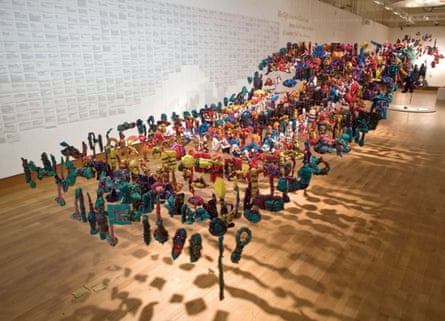
“I have to say that the loss of my mother, particularly coming so soon after the birth of my daughter, changed the kind of work I made forever ... the work became rooted in relationship with strangers and on very intimate themes. The best known of these, which involved hundreds of members of the public in its production, was The Gifts (2010), a collection of 999 objects given to me that represented a loss or an ending, and were ritually wrapped in cloth with donors then designed into a suspended installation in the form of a receding wave, in Bristol Museum and Art Gallery. The conversations I had with donors to this project, on death, loss , longing, were transformative and brought me to a new understanding as to how art is like a language I have been given in order to face, transform and share a different kind of response to the suffering both I and thousands of others (in far worse situations) have had to go through.
“She (my mother) sometimes still appears in dreams and I have the enduring and almost incomprehensible memory of recalling a dream she shared with the four of us (her children) at a family meal in the September prior to the Tsunami that she had had the previous night. She has dreamt she was on a beautiful sandy beach, in the sun, and a huge wave came and swept her away. She looked at us and said, ‘Wouldn’t that be a beautiful way to die? You’re already in heaven, its quick, no long illnesses …’. On some level I like to imagine this was her chosen path out of this world. On others, I still mourn for the loss of a mother who left us too young, and for the devastation of so many, many lives – and livelihoods. It is the process of holding these two spaces psychologically that has lead me into a deeper relationship with life, love and loss. And for that I am grateful.”
